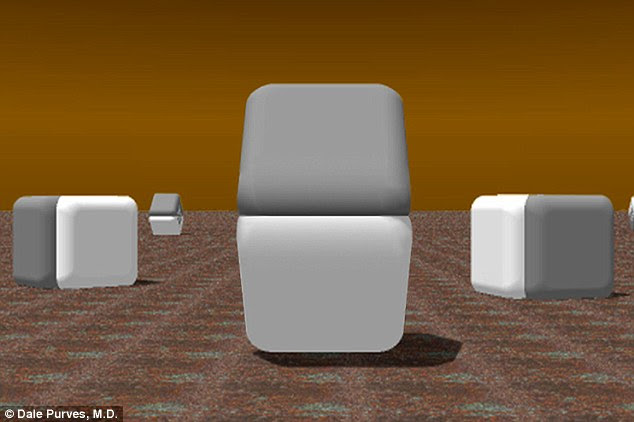Don't believe your eyes: These two blocks are the SAME shade of gray
PUBLISHED: 22:43 GMT, 9 December 2013 | UPDATED: 22:43 GMT, 9 December 2013
It's
hard to comprehend, but even though our eyes tell us that one block is
darker and the other is lighter, we shouldn't believe them.
The
two blocks are, in fact, the exact same color and only appear diferent
due to the effect of the darker and lighter shading across the middle.
Place one finger along the center, blocking the darker and lighter parts, and your eyes will begin to tell the truth.

Illusion: The top block is the same color and shade as the bottom
This illusion was documented by experimental psychologist Tom Cornsweet in the 1960s, hence its name: the Cornsweet illusion.
Cornsweet,
who is best known for his work in visual perception, noted that humans
perceive color and shade of 3D images in a certain way depending on the
way the item is lit and the way shadows fall.
More...
If
the light is falling from the upper left and the two blocks appear
tilted away from us, then we see the upper block as lit and the lower
block in shadow,
due to the light source coming from the upper left of the image (see
how the shadow falls on the ground).

Same
same: The shades of gray here are the same, only the lighter and darker
shading in the middle make it appear that one side is slightly darker
than the other
Combined
with the contrasting shading in between the two blocks, our brain
interprets the top block as dark and the bottom on as light.
The scientists Purves, Lotto and Nundy write in American Scientist:
'[Perception] accords not with the features of the retinal stimulus or
the properties of the underlying objects, but with what the same or
similar stimuli have typically signified in the past.'
In
other words, our eyesight is reflective - we perceive the upper square
to be darker and the lower one to be lighter because that's what is
logical and what our brains expect
because of the other elements surrounding the gray.
We think it's lit from above - but it's not.










0 comments:
Post a Comment